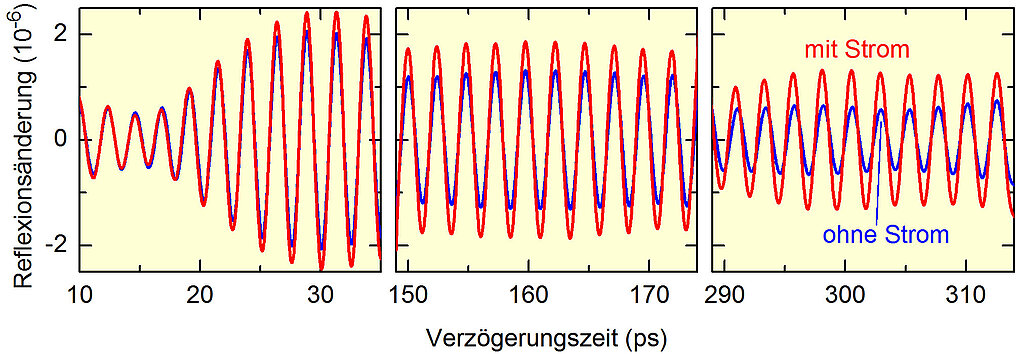Ultrasound consists of acoustic waves with a frequency well above the limit that can be heard by humans. Ultrasound in the megahertz range (1 MHz = 106 Hz = 1 million oscillations per second) is widely used in sonography, eg. For medical imaging of organs in the body and for nondestructive testing of materials. The spatial resolution of the image is limited by the wavelength of the ultrasound. In order to image objects in the nano range (1 nanometer = 10-9 m = 1 billionth of a meter), sound waves with a frequency of several hundred gigahertz (1 gigahertz (GHz) = 1000 MHz) are required. In order to use such waves as a diagnostic tool, new sources must be developed that provide sufficient sound intensity.
Amplification of sound waves at extreme frequencies
Fig. 1 Changes in the reflection as a function of the delay time after the pump pulse. The observed oscillations are proportional to the instantaneous amplitude of the sound wave. The blue curve shows the results without current through the superlattice, the red curve with a current of 1 A. The amplitude with current is always larger than that without current. The gain (the ratio between the red and blue curves) is most noticeable with delay times above 300 ps (1 ps is a picosecond, one millionth of a millionth of a second) because the gain takes time.
In a recent publication (K. Shinokita et al., Phys. Rev. Lett. 116, 075504 (2016)), researchers from the Max Born Institute in Berlin, together with colleagues from the Paul Drude Institute, Berlin and the École Normale Supérieure, Paris, a new method for the amplification of such high-frequency sound waves shown. In a specially designed semiconductor structure consisting of a series of nanosheets, sound waves with a frequency of 400 GHz are generated and detected with short optical pulses from a laser. The sound is amplified by interaction with an electric current flowing through the semiconductor in the same direction as the sound waves. This amplification is based on a process called "SASER" (Sound Amplification by Stimulated Emission of Radiation), completely analogous to the amplification of light in a laser (Light Amplification by Stimulated Emission of Radiation). The sound wave excites electrons traveling at a speed higher than the speed of sound to go from a state of high energy to a state of lower energy, thereby making the sound wave stronger. In order to obtain a net gain, it is necessary that there are more electrons in the state of high energy than in the lower energy. In this way, a sound wave with a frequency of 400 GHz is amplified by a factor of two.
Movie: The investigated semiconductor structure consists of alternating layers of gallium arsenide and aluminum gallium arsenide (shown here in yellow and red). A short laser pulse (arrow from left) generates an acoustic wave, visible here as a periodic change in the layer thicknesses. While the amplitude of the acoustic wave increases with time when an electric current (moving electrons represented as blue dots) flows, it remains constant without current (upper part).
The previous work demonstrates for the first time this principle of sound amplification. In order to build a usable source of high-frequency sound waves, it is necessary to further increase the gain, which should be possible by improving the structure and, above all, by better cooling of the semiconductor. Once such sources are available, sonography can be operated with a resolution in the range of the size of viruses, that is on a length scale much shorter than the wavelength of visible light.
Search publications of MBI
Publications since 2025
